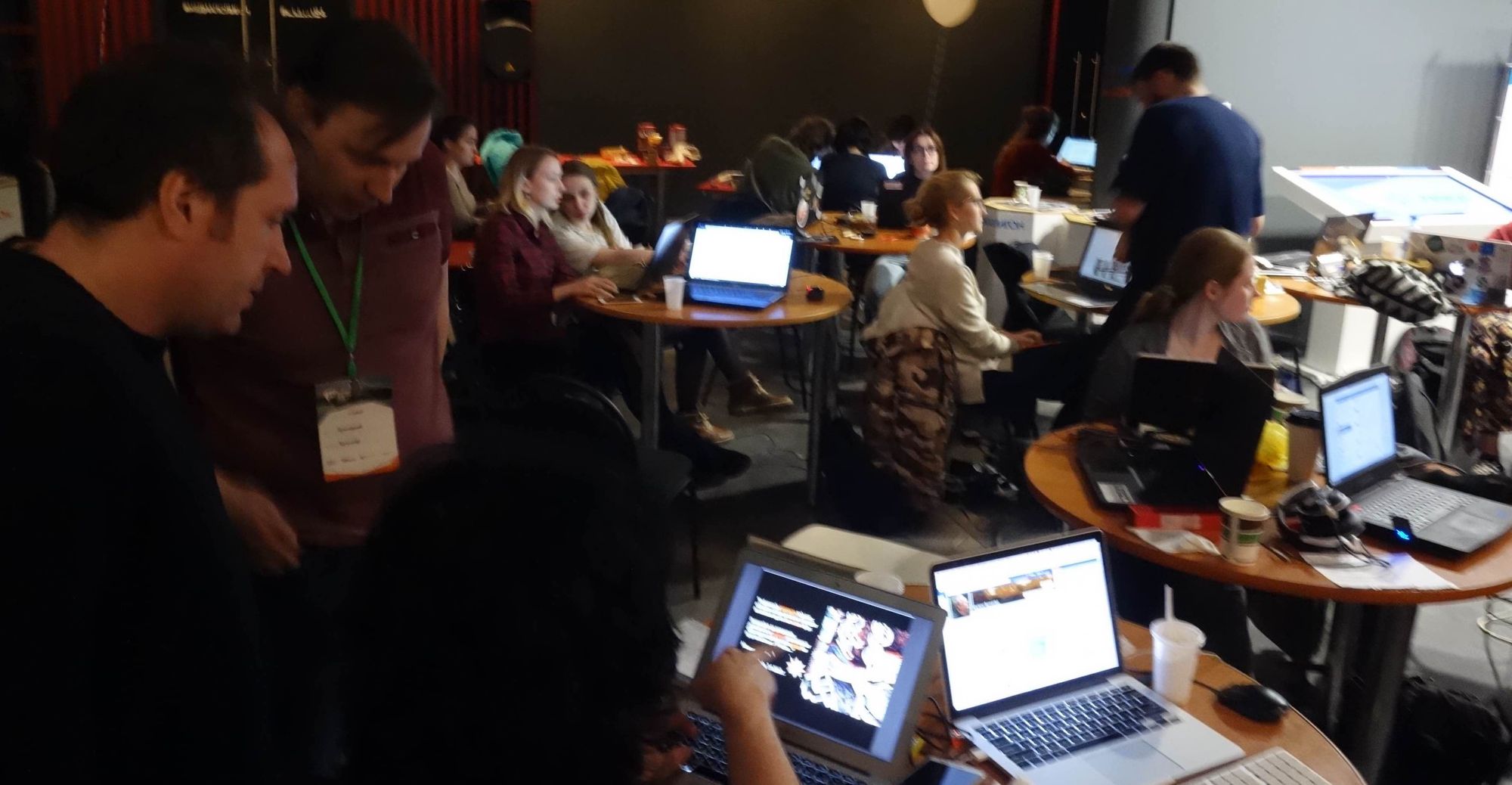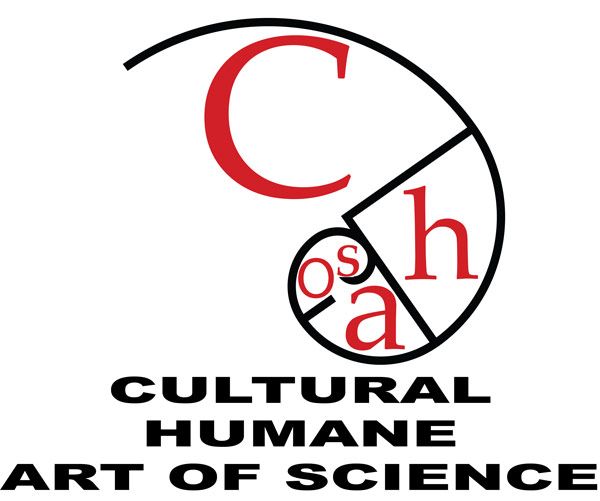Our intervention in the journalism space is, we believe, as important as our interventions in education, research and democracy spaces. Why? In the past, journalism was "invented" to disseminate news, opinions, inform society. In the middle of the 20th century, its mission was re-established by BBC as "responsible and truthful informer of society." Though recently we have been witnessing an increased information overload and focus on populistic news, it does not reduce its primary role as critical infrastructure for informing society.
Today's problems with journalism are instead to do with the health of the journalistic ecosystem - the exact aspect we are interested in working on. Journalism needs to develop independence of financial sources, which will heal an even more intrinsic problem - journalism should be able to not depend on the needs of society, but rather to assume (at least partially) a role in shaping society.
Just take for an example a well-known fact: that society is much more interested in negative news than in positive, and the anthropological reason behind it - negative news have always been entropically and existentially much more valuable throughout human history. Another relevant psychological phenomenon is about humans consuming news - when a person reads a text, each new piece of information brings pleasure and fulfillment, in a sense positively correlated with the text's entropy. This phenomenon can furnish a psychological explanation for society's shift toward instant and short news, the rise of Twitter among social media, etc.
These two examples are just a short explanation of the complexity of the role of journalism, and its responsibility for the healthy functioning of any collective mind ecosystem.
Co-Creating an Innovation Ecosystem for Good Journalism - Barcelona
| Event | Co-Creating an Innovation Ecosystem for Good Journalism |
|---|---|
| Place | Santa Mònica Arts Centre, Barcelona, November 13-16, 2011 |
| Aspects | journalism, collaboration (on the news), crowdsourcing news, sustainability |
| Components | KnAllEdge, Knowledge Gardening, IBIS |
| Members | (alphabetical order) Paddy Coulter, Dino Karabeg, David Price, Sasha Rudan, Ramon Sangüesa |
The value of this event was to build a network of local and international stakeholders in journalism and understand the challenges of modern journalism in terms of financial sources and information flow from the source over journalists toward consumers.
Below is a proactive process journalism loop presented at the journalism innovation event (fig. journalism-innovation). The bottom part of the loop addresses the journalistic domain and the process of searching for information and transforming them into "moving" social artefacts. These artefacts are in the second (top) part of the loop disseminated to society where the society is taking an active role of building awareness and co-organizing into the crowd willing to change the state of affairs and feeding back to the journalist what they saw, closing the loop in a sustainable way. Through that process, a 2nd dimension of "reaching society" is emerging as a thrivability factor for social progress, an essential and expected role of any information-dissemination structure such as journalism.
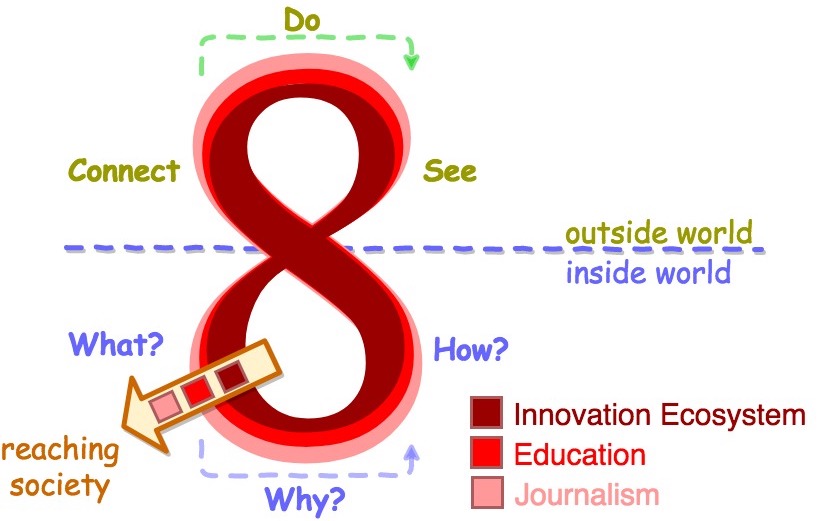
Figure journalism-innovation: a Why-Do infinity loop of innovative journalism
Though we did not continue with this initiative and the event participants, it was still precious for our future work on the journalism model and an enabler of our future actions, that we present in the following sections.
Mediapolygon, Tyumen, Russia
| Event | Mediapolygon CoLaboArthon |
|---|---|
| Place | Tyumen, Russia, April, 2017 |
| Aspects | creativity, collaboration, multi sapiens, journalism, systemic innovation |
| Components | Colaboarthon |
| Members | [TODO:] |
Mediapolygon (http://mediapolygon.ru/) is a complex event (a set of week-long events) with a long tradition organized by the Russian Reporter. It attracts journalists, photographers, and videographers to a single spot, a kind of singularity, in a given Russian town, providing a media cross-section of that city - this time it was Tyumen, Siberia. (http://gototyumen.com/events/mediapoligon-tyumen-24)
However, this time their news have not stayed in Russia only. Some were spread around the world and reached artists from 13 countries and four continents, who reacted on touching news from Tyumen and started sending their emotions, in the form of poems, songs, paintings, compositions, back to those people in Siberia, back to the source of the journalistic reports.
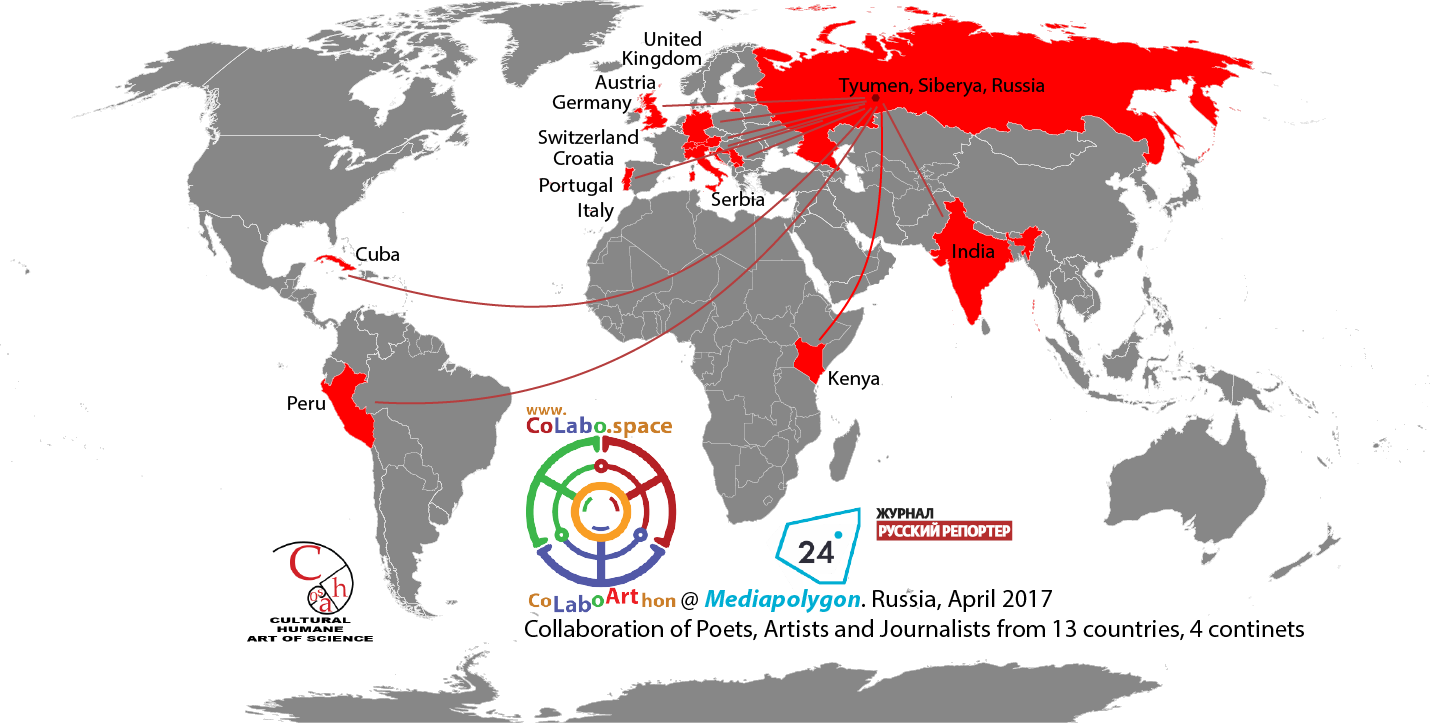
Figure colaboarthon-mediapolygon-map: International CoLaboArthon uniting journalists and poets from 4 continents
What happened is that Mediapolygon got in touch with our research group and, with the help of Metaversity and Protopia, we jointly organized a CoLaboArthon (please see under the section "Colabo.Space methodologies" in the chapter "") - a fusion between journalists and artists, between Russia and the rest of the world. The reason for this fusion is not merely an experiment - it is an exploration of Systemic Innovation of Journalism through its holistic positioning and defragmentation + collaboration of cultural and research areas.
A CoLaboArthon (its goal being to increase communication quality across disciplines, senses, and places) helps journalism to translate facts into emotions, to tell additional dimensions of truth - it moves society, it helps in calling for action, for change. In that sense, the CoLaboArthon offered an answer for a missing part of the social thrivability cycle. In the ideal case, a CoLaboArthon is a dialogue/flow between facts (science/research/journalism) and society, but it is also an intercultural exchange and travel, a chance for deep connection through collaboration.
The CoLaboArthon format relies on the Colabo.Space ecosystem that helps collaboration between participants or matching the most relevant writings with artists’ interests, extraction and sharing the essence of news articles or artists’ style.
Particular Colabo.Space methodologies (like creative cards, brainstorming and innovation methodologies) also help to foster ***creative leaps ***. We see benefits for journalists through provoking long creative leaps, helping them to discern facts from a different viewpoint, to see creative/dramatic/emotional details, and improve collaboration among journalists.

Figure mediapolygon-hq: Vitaly Leibin, Chief Editor of the Russian Reporter magazine, examining CoLaboArthon results at Mediapolygon headquarters.
It was fascinating to see how, given the right atmosphere, an artistic environment (even through a socio-IT ecosystem), and a customized inspiration, poets were able to create a poem of good quality in a short time. Under these requirements, poets created poetry that was deeper connected to their initial emotions, came from their guts, and invited further artistic collaboration.
This ad-hoc cooperation turned into a prolonged one, as we connected Mediapolygon - Journalistic marathon with Belgrade Reader - Literary Marathon (Serbia) (fig. story-artists), where news and art from Tyumen were retold and inspired more writers for future CoLaboArthons (http://pancevo.mojkraj.rs/vesti/kultura/item/4993-pancevacke-pesnikinje-u-ruskom-reporteru).

Figure story-artists: Illustration of artists responding to a specific news
There is a lot of inspiration for the next steps. This event was just a demonstration of CoLaboArthon. At the next Mediapolygon, our goal is to integrate full-fledged Colaboarthon with the www.colabo.space ecosystem, with www.metaversity.ru and Mediapolygon solutions like www.les.media. We discuss that integration further in the next section on process journalism.
Process journalism
| Event | Mediapolygon - Process journalism |
|---|---|
| Place | Tyumen, Russia, April, 2017 |
| Aspects | journalism, creativity, collaboration, multi sapiens, crowdsourcing, systemic innovation, field work |
| Components | ColaboArthon, CoEvoLudens, ColaboFlow, Multi Sapiens |
| Members | [TODO:] |
We were involved at the Mediapolygon (Tyumen) event with multiple roles: 1) invited researchers giving a talk on collaboration and dynamic systems for collaborative journalism, 2) participating in fieldwork with other journalists, 3) designing an interconnected journalistic ColaboArthon event and 4) designing a new model of process journalism.
The first role gave us a chance to reach both journalists and researchers and enable the 4th role. The acceptance of our presentation helped us to join the core team of Mediapolygon organizers and get invited as expert advisors for their new system for modern journalism called LES (https://les.media/).
During our fieldwork, we experienced rapid and engaged journalism (a form that is already practiced at the Mediapolygon). In short, during the "сутки" (Russian for 24 hours) hundreds of journalists, photographers and videographers would spread over the town and explore its different aspects, deliver news to the "штаб" (Russian for Headquarters), handshake improvements and move on. As a reader can see, there is already a notion of dynamics, flow, and structuralism in this event.
However, at the level of organizers and participants this process, though very entertaining and exciting, was very often seen as a rush, encouraged competitiveness and reduced participants' engagement. At the same time, organizers told us that through different iterations of the same event participants tended to repeat their mistakes. We needed to identify the journalistic process, redesign it, externalize it and address its particular phases in greater detail.
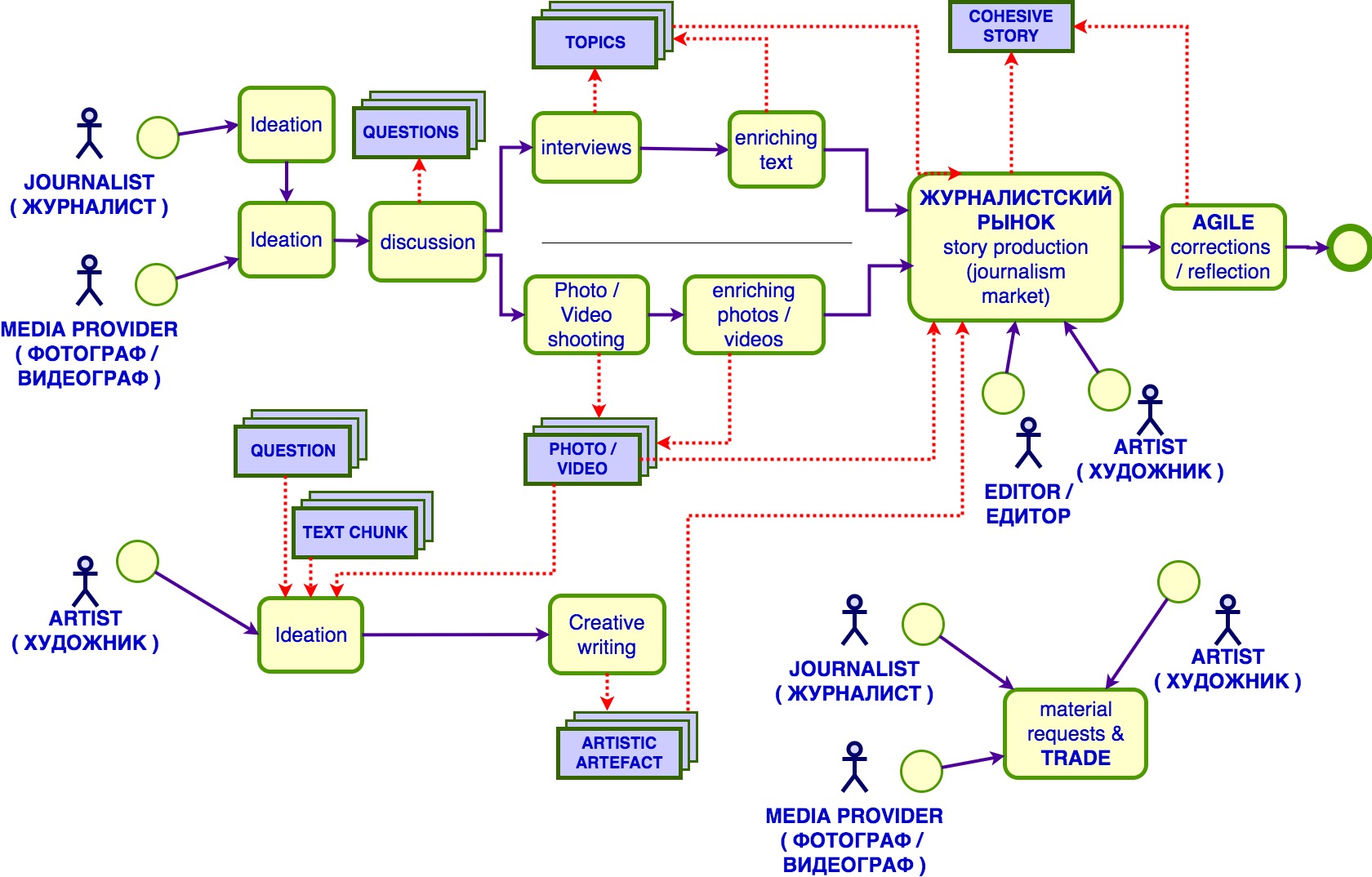
Figure journalism+art: A model of process journalism engaging art and closing the loop of society
Through this and the creation of an online ad-hoc “journalism market” of ideas and assets, we looked for a deeper connection “on the field.” We then designed the process as a flow of goods and values across the network, where each participant does not necessarily own the goods, but rather possess then during the "improvement" period, after which she/he passes them to another stakeholder until the goods are ready for delivery (publishing) or, in the worst case, disqualified.
The proposed concept resonates very much with the notion of a transactional object: "it [findings] puts forward the idea that news has become a transportive, transactional object of professional, social and civic work for both journalists and audience members.." (Robinson, 2011) and brings us back to the (fig. journalism-innovation) that portrays sustainable journalism.
In the domain of process journalism (one of the rarely recognized professional processes that are practiced and not business processes) we have started a correspondence with academic journalists regarding further research in this domain. We will continue designing more controlled experiments, with a possibility to measure motivation, satisfaction, collaboration, and news efficiency.
